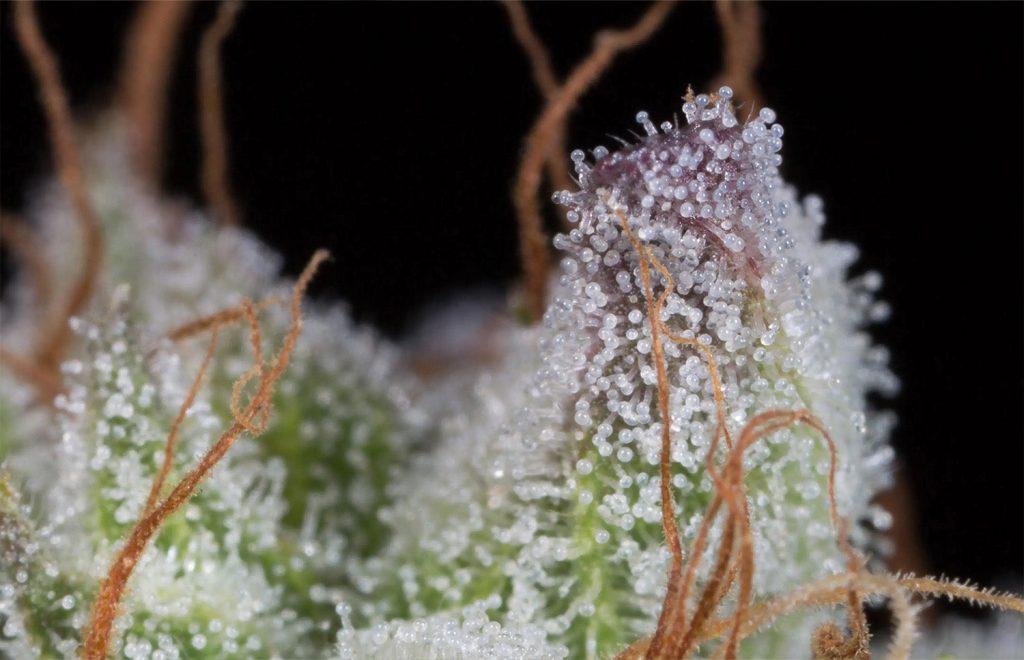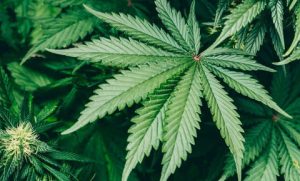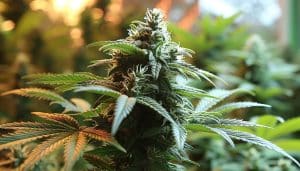- As we already explained to you in our first article, cannabis terpenes are responsible for the aroma and flavor of the plant.
- In this second article, we present the main terpenes contained in the cannabis plant and we describe their specific properties. Follow the leader !
1) Primary monoterpenes :
They are composed of 2 units of isoprene, in other words, two blocks of 5 units. The best known monoterpenes are myrcene, alfa and beta-pinene (has-pinene and β-pinene), THE limonene, THE beta-caryophyllene (β-caryopphyllene), THE terpinolene And the ocimene.
Myrcene:
THE myrcene or β-myrcene is a monoterpene. It is undoubtedly the terpene that we find most commonly in the cannabis plant, because it constitutes 50% of the total essential oil production of the latter. Its aromatic influence reflects a mixture earthy, of musk And grass. Myrcene is the precursor to other terpenes.
A number of studies confirm that it is the dominant phytoterpene In a large majority of Indica-dominant strains, whose effect is sedative and relaxing. It would seem that if the plant contains a concentration greater than or equal to 0.5% of myrcene, then its action would be more marked in this direction. Other studies mention that this terpene would be interesting for treating problems insomnia. It appears that it also has properties anti-inflammatories, antibiotics And antimutagens.
Pinene:
THE pinene is a bicyclic monoterpene, which simultaneously expresses an obvious double aromatic expression similar to that of pine and fir tree. Two structural isomers are naturally present in our environment: α-pinene And β-pinene, the first being the one found most frequently.
This terpene has a function protective for the cannabis plant, because it has an effect repellent against pests. It can also be found in many other species of the plant world, such as the parsley, THE rosemary, dill, THE basil and the conifers.

A number of scientific studies confirm that pinene has properties anti-inflammatories, bronchodilators even anti-carcinogens proven. A clinical study carried out in 2011 demonstrated that α-pinene acts as an inhibitor of acetylcholinesterase, and that it is capable of modulating the activity of this enzyme, which can contribute to an improvement in memory and processes. cognitive.
This is why we can deduce that it offers the possibility of attenuating the effects produced by THC. Most cannabis strains with a high pinene content, generally produce an effect energizing.
Limonene:
THE limonene is a monocyclic monoterpene, which explains why certain cannabis strains offer us this delicious and intense citrus scent. We see that the varieties resulting from Highest quality cannabis seeds containing a high level of limonene, produce an effect invigorating. This terpene is found in certain aromatic herbs such as rosemary, there mint, and also in all citrus.
From a physiological point of view, limonene is known for its many virtues antibacterial, antioxidants And antifungals. On a psychological level, the latter acts as an excellent natural antidepressant, because it has the ability to significantly improve mood.
Some scientific studies claim that this terpene has the power to help restore homeostatic balance. While knowing that the imbalance of neuroendocrine and immune function (which directly affect homeostasis), is directly linked to psychosomatic or psychiatric disorders, limonene could act effectively on the treatment of diseases such as the Depression or various anxiety disorders.
Beta-caryophillene:
THE β-caryophyllene is a sesquiterpene that is found quite frequently in cannabis, but also in Basilica, THE clove and the cinnamon. It is responsible for the aromatic influence, slightly spicy And wooded of certain genetics. Which allows us to understand logically that it constitutes one of the active ingredients of black pepper. This specific terpene could be considered a cannabinoid in its own right, as it selectively binds to the CB2 receptor.
Terpinolene:
THE terpinolene is a terpene which is often present in a very wide range of cannabis strains, but generally in a very small proportion. Varieties in which terpinolene is dominant are uncommon. This terpene has a fairly complex organoleptic profile, as it can be described as a woody blend, herbaceous And floral.
It is found in the lilac, the tea tree, THE apples, THE cumin or even the nutmeg. Studies carried out in the laboratory, and more precisely on mice, have demonstrated that its inhalation produces effects sedatives. It also seems that this terpene has properties anticancer And antioxidants. Other recent scientific research also explores the role of terpinolenes in the prevention of coronary heart disease, using other antioxidants.
The ocimene:
The ocimene offers a sweet floral scent And wooded, quite subtle. As with terpinolene, it is a terpene present in a very large sample of cannabis varieties, however rare are those where this aromatic component is dominant. It is also found in a large group of plants, such as hop, THE kumquat, there mango, THE basil, there bergamot, there lavender, THE orchids or even the pepper, in varying quantities.
Ocimene is widely used in the perfume industry, due to its sweet, floral and herbaceous flavor profile. There is scientific evidence revealing its properties anti-inflammatories. Generally speaking, it is produced by a plant to act as a powerful repellent faced with insect pests, it therefore plays a protective role.
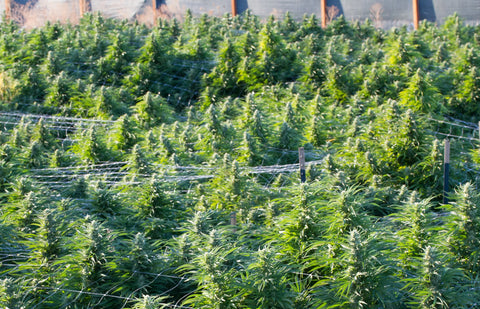
2) Secondary terpenes Or sesquiterpenes :
They are composed of 15 carbon atoms. THE sesquiterpenes that are most often found in cannabis are the Carene (delta-3-carene), caryophyllene oxide, THE fenchol, the humulene, the linalool, eucalyptol, bisabolol, THE nerolidol (Or Peruviol), alpha-phellandrene (has-phellandrene), THE camphene, α- β-Y-terpinenes, THE farnesene or even the terpineol.
Delta-3-carene:
THE delta-3-carene is one of the main components of pine essential oils. It has properties known as phytoncide (name given to a set of antimicrobial volatile organic compounds emitted into the air by trees and herbaceous plants), it also demonstrates effects anti-inflammatories And anxiolytics. Additionally, recent studies have demonstrated that carene has a sleep-enhancing effect and that oral administration of delta-3-carene increases sleep duration and reduces sleep latency. It potentiates synaptic responses that are moderated by GABAA receptors, by prolonging the decay time constant of inhibitory synaptic responses.
Caryophyllene oxide:
Caryophyllene oxide is a sesquiterpene epoxide whose fragrance can be described as costs, soft, dry, wooded And spicy. This is precisely a component used by drug-sniffing dogs to identify cannabis. It interacts with the system endocannabinoid. It is commonly found in field wormwood, salted heliotrope, there cinnamon, there sticky sage and the basil.
Fenchol:
THE fenchol presents an aromatic profile dominated by camphor, strong And costs. This terpene demonstrates a broad spectrum antibacterial activity, and may play a role in pain relief through inhibition of the TRPA1 receptor, which is a fundamental protein in the body’s pain signaling system.
Humulene:
Humulene is also known as of α-caryophyllene (alpha caryophyllene), it is a terpene that is found in the hop flower cone. Humulene contributes significantly to the effects anti-inflammatories cannabis. It is also considered an active mechanism in fighting tumors, as evidenced by its ability to produce reactive oxygen species (ROS).
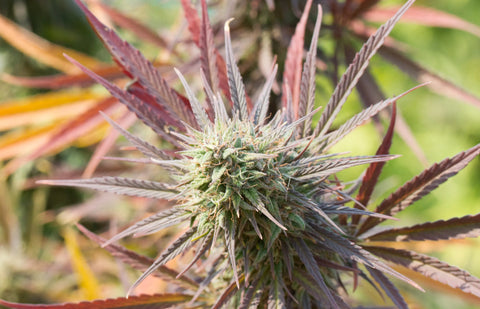
Linalool:
THE linalool is a monoterpene alcohol widely present as a major constituent of plant essential oils, particularly regarding the lavender and the coriander. Linalool does not present any particular toxicity in itself, it has even been shown to possess a full range of bioactive synergistic virtues, including properties anti-inflammatories, anticancer, anti-hyperlipidemics, antimicrobial, antinoceptives, painkillers And neuroprotective. Additionally, linalool produces anxiolytics and antidepressants through the serotonin 5-HT1A receptor.
Eucalyptol:
Eucalyptol gives off, as its name suggests, a strong odor fresh, marked And slightly spicy eucalyptus. We frequently find this terpene in eucalyptus as in certain varieties orchids. Scientific investigations have revealed that eucalyptol demonstrates properties anti-inflammatories And painkillers obvious.
Bisabolol:
THE bisabolol has quite a scent soft, close to citrus and some chamomile. It is found in chamomile and other natural aromatics. It is a terpene widely used in the perfume industry. Some institutional studies have demonstrated that bisabolol has properties anti-inflammatories And antibacterial.
Nerolidol:
THE nerolidol is a sesquiterpene alcohol that is found as a major element in the composition of essential oils of neroli, of Myrocarpus fastigiatus and of Brassa volanodosa. It is also present in a smaller proportion in the ginger, there lavender and the lemongrass. This terpene is commonly used in perfumery, thanks to its aromatic profile floral, fruity, costs, intense And particular. It is also used in the production of eau de cologne. It seems that nerolidol has virtues antiseptics, energizing And anti-fungal.
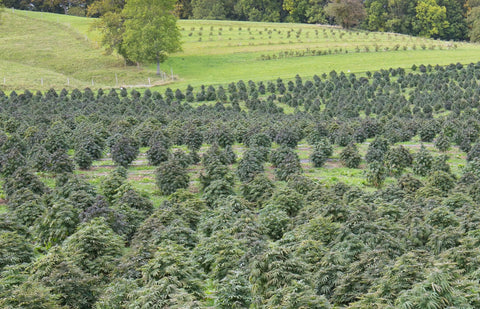
Alpha-phellandrene:
Alpha-phellandrene gives off a pleasant smell of mint And citrus. It is the main constituent of essential oils from certain varieties eucalyptus. Scientific studies show that a-Phellandrine can have multiple beneficial properties, such as strengthening of the immune system, or even properties antifungals, anti-inflammatories And painkillers.
Camphene:
THE camphene is a terpene that has an odor spicy And herbaceous. It is a major element in the composition of mastic gum oil. It is also found in minor quantities in the essential oils of turpentine, of cypress, of camphor, of lemongrass, of neroli, of ginger and of valerian. Camphene has effects hypocholesterolemic And hypotriglyceridemic, which allow better internal preventive regulation of the cholesterol and triglycerides. It is also used for applications in Ayurvedic practice.
α- β-Y-terpinenes:
THE alpha, beta And Y-terpinenes are present in the allspice, eucalyptus, THE citrus, THE juniper, the tea tree, there cardamom and the marjoram. The α (alpha) isomer is also being studied as an anticancer compound.
Farnesene:
THE farnesene gives off a strong smell of greenery and of apple. It is found in minority quantities in the basil, there apple, there mint and the ginger. It is used by some insects for communication. It is also present in certain plants which use it as pest repellent. Farnesene is an element used in the manufacture of tires in the automobile sector, as well as in the development of numerous fragrances in the perfume industry. It appears that it has properties antibacterial interesting.
Terpineol:
THE terpineol is a monocyclic monoterpene alcohol, which is mainly found in the essential oil of pine, as in other trees as well as certain plants (lavender, juniper, lovage And marjoram). It is identified by its scent similar to that of Lily of the valley, of lilac and some hyacinth. Terpineol is used for making soaps and also for other uses in cosmetics. A scientific study shows that it could act beneficially for fight against depression.

3) Tertiary terpenes:
These are those found in small quantities in the cannabis plant: borneol, guaiol, cedrene, camphor, phytol, gerany acetate, pulegone, cymene and isopulegol (acetate of menthyl).
Borneol:
THE borneol is a monoterpene, which can be identified using its odor minty, herbaceous, and even wooded. The latter is present in the ginger, mugwort, artemisia, THE rosemary, there sage, oregano and certain types of cinnamon. It is used by industrial manufacturers for the development of different products insect repellents. It seems that it plays an important role in the entourage effect, complementing the action of other terpenes.
On the therapeutic level, recent scientific investigations have shown that it contributes quite effectively against apoptosis of cancer cells, in other words, it causes the natural death of the latter. Other studies mention that it also has properties antivirals, since it is a powerful inhibitor of herpes simplex virus type 1.
The guaiol:
THE guaiol is a sesquiterpene alcohol, whose aromatic profile is similar to that of pine, and that we can therefore easily confuse it with the pinene. This is present in certain trees, such as guaiacum, THE pine and the cypress. On a medical level, it turns out to be interesting, because it has strong potential anti-inflammatory, antimicrobial, antibacterial, antifungal And anti-virus.
Cedrene :
THE cedrene is a sesquiterpene found in cedar essential oil, which is extracted from the tree of the same name. This terpene constitutes a formidable pest control And anti-inflammatory natural.
Camphor:
THE camphor is a bicyclic terpene, derived from camphor tree (Cinnamomum camphora). It can easily be confused with the borneol, because their smell is quite similar. It’s an excellent antifungal And pest control, because it demonstrates strong effectiveness by actively fighting against pathogenic fungi and producing a powerful repellent effect against harmful insects. It has been observed that camphor has interesting properties antiseptics, anti-inflammatories And antimicrobial.

Phytol:
THE phytol is one of the main acyclic diterpene alcohols, which is a precursor of vitamins E and K. It is a very common terpene, which is found in many plants esterified chlorophyll as the green tea, or even the milk, THE eggs and also in the petroleum sediments. It gives off a strong smell floral balsamic And fresh, this is one of the reasons why it is used in the cosmetic sector. Several scientific studies have demonstrated that it has virtues soothing, digestive, anti-oxidants, anti-inflammatories, anti-carcinogens and that it also strengthens the immune defenses.
Geranyl acetate:
Geranyl acetate is a monoterpene that has a characteristic scent floral And fruity reminding us of that of pink. It is naturally present in oils of lemongrass, of roses, palmarosa or else coriander. Geranyl acetate is widely used in cosmetics as a fragrance agent in the manufacture of soaps and creams. This terpene has properties soothing, antispasmodics, painkillers And anti-inflammatories.
The pulegone:
THE pulegone is a monocyclic monoterpene that gives off a strong odor that reminds us of pepper mint, of pouliot and the camphor. This terpene is used in the aromatherapy sector as well as in perfumery. It can prove to be a powerful natural insecticide against pests, but be careful, because it can be toxic in high concentration. Fortunately, pulegone is present in minute quantities in the cannabis plant.
The cymene:
Cymene is a monoterpene whose aromatic profile is intensely herbaceous And spicy. It is generally found in essential oils of cumin and of thyme. Multiple international scientific investigations have revealed that cymene is a powerful analgesic natural and that it also has properties anti-inflammatories, antibacterial, antifungals, antivirals And expectorant.
Isopulegol:
Isopulegol or menthyl acetate, is quite simply a precursor of menthol, it is a monoterpene alcohol whose aroma is intensely minty. It is present in the pennyroyal mint And lemon eucalyptus. Therapeutically, scientific studies have demonstrated that isopulegol has virtues painkillers, anxiolytics, relaxing, gastroprotective And anti-inflammatories.
